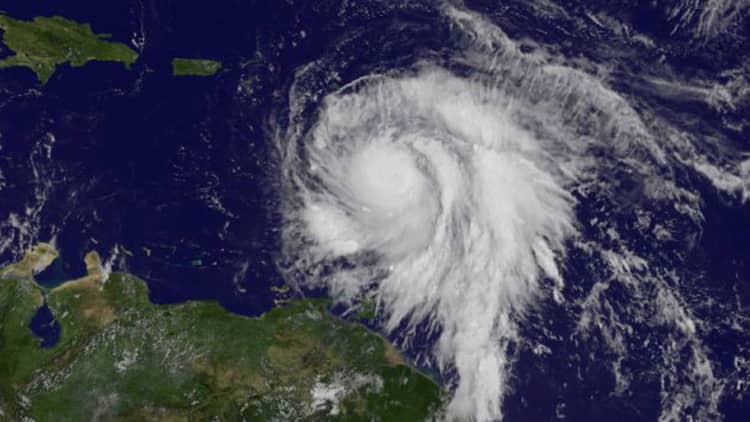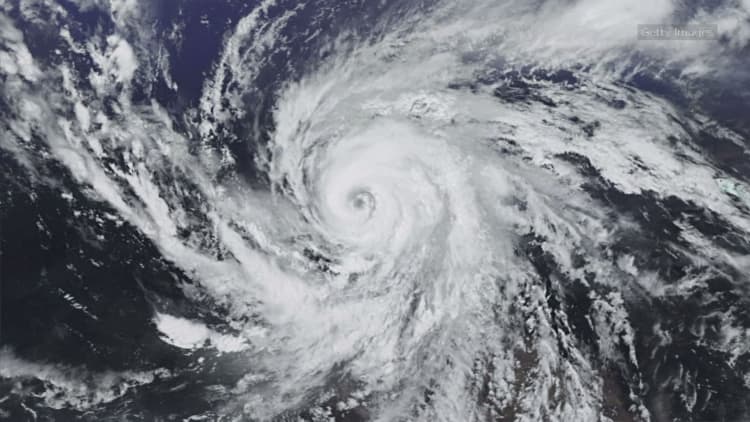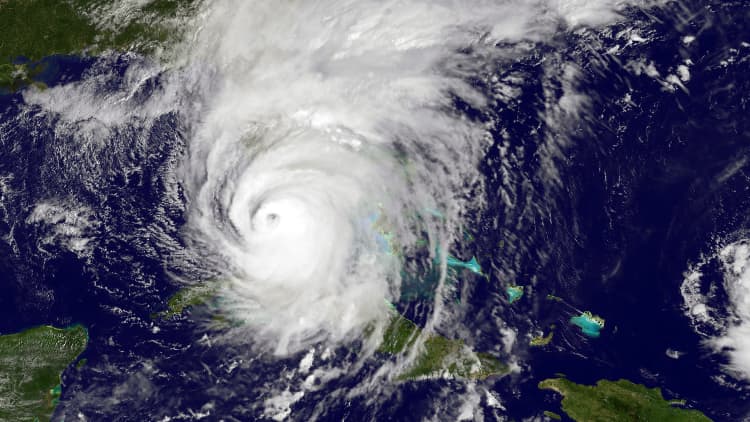
Hurricane Maria weakened to a Category 2 storm on Wednesday with maximum sustained winds of 110 mph, according to the National Hurricane Center, after rampaging across the U.S. territory of Puerto Rico.
Maria had made landfall on Puerto Rico early Wednesday as a Category 4 hurricane, the most powerful storm to hit the island in 90 years, leaving widespread flooding and power outages in its wake. The mayor of the capital city of San Juan said that power was down across the entire island.
Maria, the second major hurricane to roar through the region this month, carried winds of up to 155 miles per hour (250 kph) when it landed near Yabucoa, on the southeast of the island, just after 6 a.m. ET.
It ripped the roofs off some buildings and turned low-lying streets into rushing debris-laden rivers.
The streets of historic Old Town in the capital, San Juan, were strewn with broken balconies, air conditioning units, shattered lamp posts, downed power lines and dead birds. Few trees escaped unscathed: thick branches were torn down from most and others were simply uprooted.
"The danger continues - there are flood warnings for the whole of Puerto Rico," Governor Ricardo Rossello warned residents on Twitter as the storm headed offshore. "Stay in safe places."
Before weakening, Maria had strengthened to a Category 5 hurricane, making it the second maximum-strength storm to hit the Caribbean this month. It left at least 9 people dead across the island region.
The storm plowed into Dominica, a mountainous country of 72,000 people, late on Monday causing what Prime Minister Roosevelt Skerrit called "mind-boggling" destruction.
"The winds have swept away the roofs of almost every person I have spoken to or otherwise made contact with," Skerrit said on Facebook, noting that his own residence had been hit too. He said his focus was now on rescuing people who might be trapped and getting medical help for the injured.
North of Dominica, the French overseas territory of Guadeloupe appeared to have been hit hard. The Guadeloupe prefecture said one person was killed by a falling tree and at least two people were missing in a shipwreck.
Some roofs had been ripped off, roads were blocked by fallen trees, 80,000 households were without power and there was flooding in some southern coastal areas, the prefecture said in Twitter posts.
Video footage released by the prefecture showed tree-bending winds whipping ferociously through deserted streets and shaking lamp posts when the storm first hit.

The region was punched just days ago by Hurricane Irma, which ranked as one of the most powerful Atlantic storms on record. Irma devastated several small islands, including Barbuda and the U.S. Virgin Islands of St. Thomas and St. John, and caused heavy damage in Cuba and Florida, killing at least 84 people in the Caribbean and the U.S. mainland.
Many U.S. Virgin Islands residents were fleeing to shelters around midday Tuesday. Mapp urged islanders to focus on saving themselves.
"You lose your life the moment you start thinking about how to save a few bucks to stop something from crashing or burning or falling apart," he said. "The only thing that matters is the safety of your family, and your children, and yourself. The rest of the stuff, forget it."
U.S. airlines said on Tuesday they would cap one-way fares at $99 to $384 to aid evacuations.
Maria was predicted to be the worst storm to hit St. Croix since Hugo, a Category 4 storm, in 1989.
Hector Cintron, who works at a telephone company on St. Thomas, said he had spent the past couple of days preparing generators, securing his belongings and clearing debris as he and his neighbors prepared for a repeat of Irma.
"There's a lot of stress and a lot of anxiety. It's off the charts," he said. "The community is coming together, and helping people out. That's the good thing."
'Time to act'
In Puerto Rico, a U.S. territory with about 3.4 million inhabitants, Governor Ricardo Rossello urged residents to go to official shelters, saying, "It's time to act and look for a safe place if you live in flood-prone areas or in wooden or vulnerable structures."
Puerto Rico avoided a direct hit from Irma two weeks ago as that storm skirted north, although it still saw damage.
In the neighborhood of Miramar in Puerto Rico's capital, San Juan, Gerry Garraton said he was ready for the storm.
"I am prepared. I have water, I have cash, I boarded up my windows, I have gas. That's it," said Garraton, smoking a cigarette on the sidewalk near his home.
Garraton, 58, planned to be alone in his apartment in Miramar during the storm, and said he could stay there a few days, if needed.
Shelters in Puerto Rico have capacity for nearly 70,000 people, but Puerto Rico Housing Secretary Fernando Gil said he was concerned that only 299 people had taken refuge in official centers as of Tuesday morning.
Mary Luz, 43, and her daughter Summer Torres Varela, 23, who has epilepsy, went to the medical shelter at Puerto Rico Convention Center in Isla Grande, near old San Juan, on Tuesday. Torres Varela was vacationing in St. Thomas during Irma and experienced three seizures, Luz said.
Maria is the 13th named Atlantic storm of the year, the seventh hurricane so far this season and the fourth major hurricane - defined as Category 3 or higher - following Harvey, Irma and Jose, the NHC said. Those numbers are all above average for a typical season, which runs from June 1 to Nov. 30.
As the eye of the hurricane passed over eastern Puerto Rico on Wednesday morning, former governor Louis Fortuno said his island is in a more advantageous position than surrounding territories to return to pre-hurricane conditions in time for tourist season.
"There are so many other islands that are completely devastated. Puerto Rico's infrastructure is stronger, actually," Fortuno said on CNBC's "Squawk on the Street."
"We were receiving, on the island, people from other islands after Irma," he said. "I'm hopeful that by the height of the season during the holidays, Puerto Rico will be able to receive those tourists back."
WATCH: Here's why there's no such thing as a Category 6 hurricane

-- CNBC's Kevin Breuninger contributed to this report.

